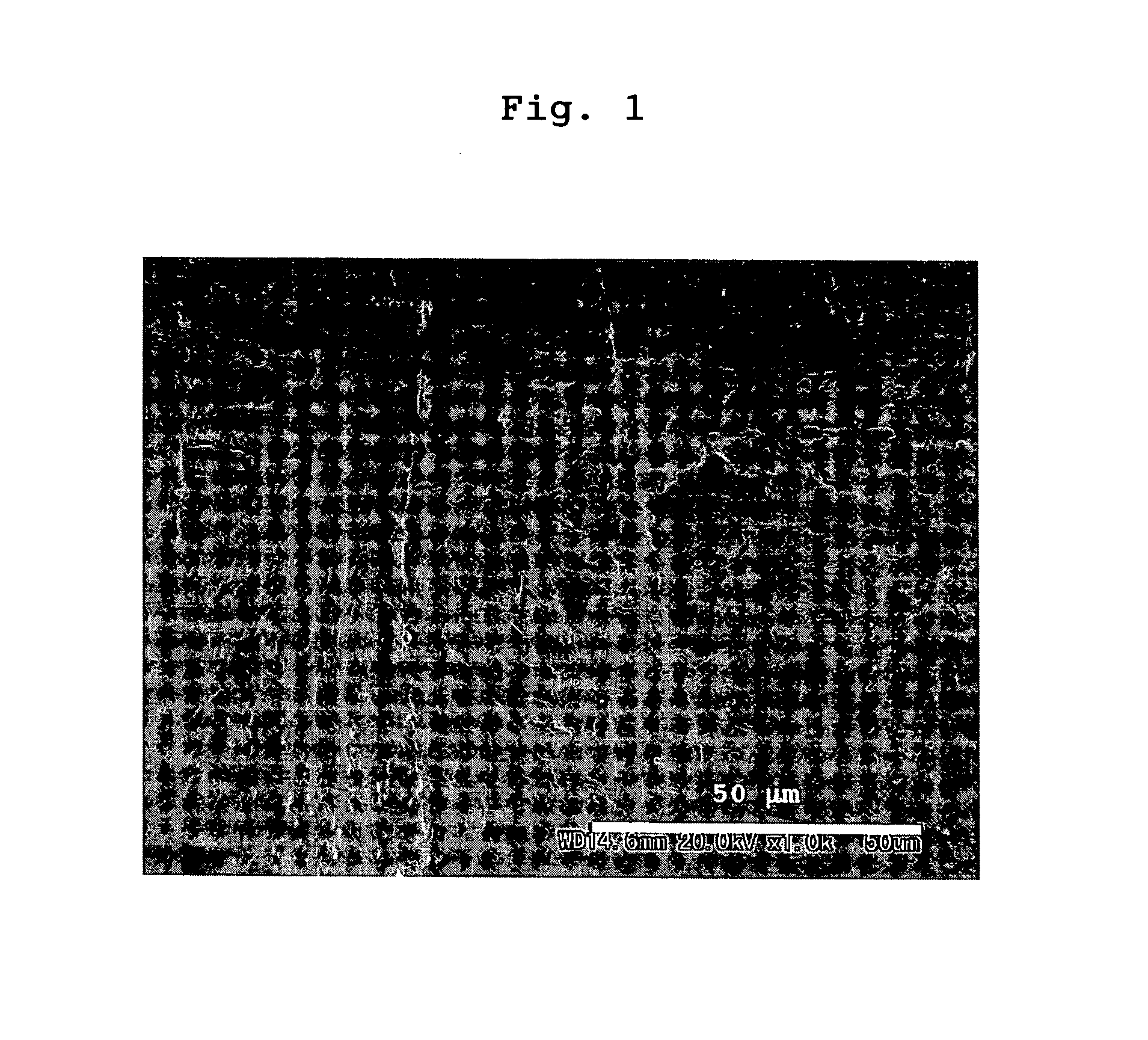Synthetic polypeptide-containing bioapplicable material and film-forming material
a technology of synthetic polypeptides and bioapplicable materials, which is applied in the direction of peptides, peptide/protein ingredients, prosthesis, etc., can solve the problems of increasing costs, reducing the application range of natural collagen, so as to achieve high bioaffinity and biocompatibility, and high safety
- Summary
- Abstract
- Description
- Claims
- Application Information
AI Technical Summary
Benefits of technology
Problems solved by technology
Method used
Image
Examples
production example 1
[0252] A peptide (5 mg (0.002 mmol)) represented by the formula: H-(Pro-Pro-Gly)10-OH (Sequence ID: 1; manufactured by Peptide Institute, Inc.) was suspended in 2 mL of dimethyl sulfoxide, and the mixture was stirred at a room temperature. To the mixture were added 0.31 mg (0.0024 mmol) of diisopropylethylamine, 0.32 mg (0.0024 mmol) of 1-hydroxybenzotriazole, and 0.46 mg (0.0024 mmol) of 1-ethyl-3-(3-dimethylaminopropyl)-carbodiimide hydrochloride, and the resulting mixture was further stirred for 7 days at a room temperature.
[0253] The reaction solution was diluted 20-fold with water, and the diluted solution was subjected to a gel-permeation chromatography (AKTA purifier system, manufactured by Amarsham Bioscience K.K., column: Superdex 200 HR 10 / 30, flow rate: 0.5 mL / min., eluent: 10 mM phosphate buffer (pH 7.4) containing 150 mM NaCl), and the peak of the molecular weight of the polypeptide was confirmed in the range from 40,000 to 200,000 in the molecular weight distribution....
production example 2
[0255] A peptide chain represented by the formula: H-(Pro-Pro-Gly)5-OH (Sequence ID: 2) was synthesized by a solid-phase synthesis with an automatic peptide synthesis machine. That is, with the use of 0.1 mmol of a particulate resin [HMP glycine, manufactured by Applied Biosystems (US)] which comprised a styrene-divinylbenzene copolymer [molar ratio of styrene relative to divinylbenzene: 99 / 1] containing 4-(Nα-9-(fluorenylmethoxycarbonyl)-glycine)-oxymethyl-phenoxy-methyl group in a proportion of 0.65 mmol / g (resin), the carboxyl terminal of one amino acid was sequentially linked (or bound) to the amino terminal of the other amino acid so as to give an object peptide. In this link reaction, 1 mmol of Nα-9-(fluorenylmethoxycarbonyl)-L-proline [Fmoc proline] and 1 mmol of Nα-9-(fluorenylmethoxycarbonyl)-glycine [Fmoc glycine], (each manufactured by Applied Biosystems (US)) were used as amino acids in each linking step.
[0256] The obtained peptide resin (resin binding the peptide) was ...
production example 3
[0261] A peptide (5 mg (0.0016 mmol)) represented by the formula: H-(Pro-Hyp-Gly)10-OH (Sequence ID: 3; manufactured by Peptide Institute, Inc.) was suspended in 2 mL of dimethyl sulfoxide, and the mixture was stirred at a room temperature. To the mixture were added 0.23 mg (0.0018 mmol) of diisopropylethylamine, 0.24 mg (0.0018 mmol) of 1-hydroxybenzotriazole, and 0.65 mg (0.0034 mmol) of 1-ethyl-3-(3-dimethylaminopropyl)-carbodiimide hydrochloride, and the resulting mixture was further stirred for 7 days at a room temperature.
[0262] The reaction solution was diluted 20-fold with water, and the diluted solution was subjected to a gel-permeation chromatography (AKTA purifier system, manufactured by Amarsham Bioscience K.K., column: Superdex 200 HR 10 / 30, flow rate: 0.5 mL / min., eluent: 10 mM phosphate buffer (pH 7.4) containing 150 mM NaCl), and the peak of the molecular weight of the polypeptide was confirmed in the range from 60,000 to 200,000 and over in the molecular weight dis...
PUM
| Property | Measurement | Unit |
|---|---|---|
| Wavelength | aaaaa | aaaaa |
| Wavelength | aaaaa | aaaaa |
| Structure | aaaaa | aaaaa |
Abstract
Description
Claims
Application Information
 Login to View More
Login to View More - R&D
- Intellectual Property
- Life Sciences
- Materials
- Tech Scout
- Unparalleled Data Quality
- Higher Quality Content
- 60% Fewer Hallucinations
Browse by: Latest US Patents, China's latest patents, Technical Efficacy Thesaurus, Application Domain, Technology Topic, Popular Technical Reports.
© 2025 PatSnap. All rights reserved.Legal|Privacy policy|Modern Slavery Act Transparency Statement|Sitemap|About US| Contact US: help@patsnap.com

